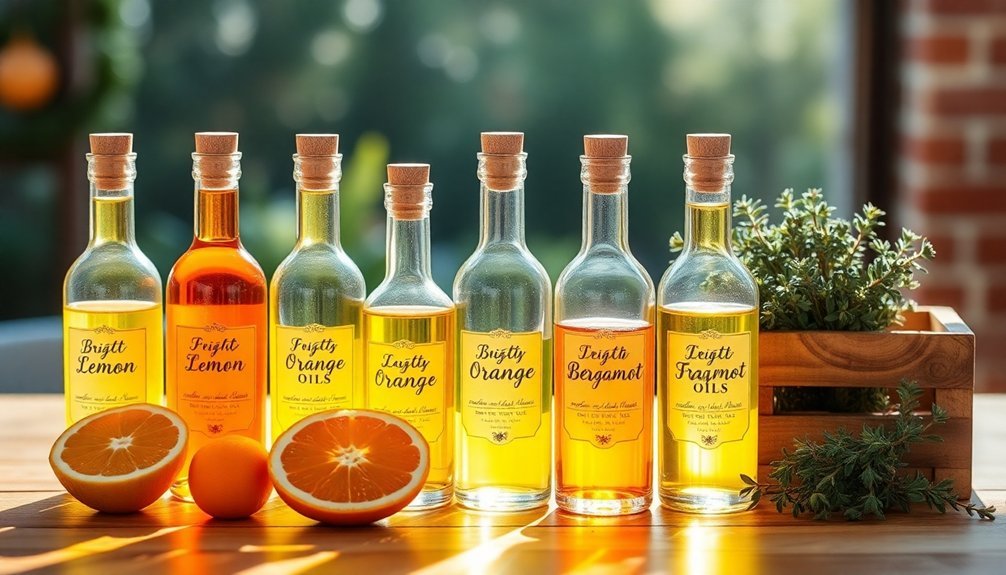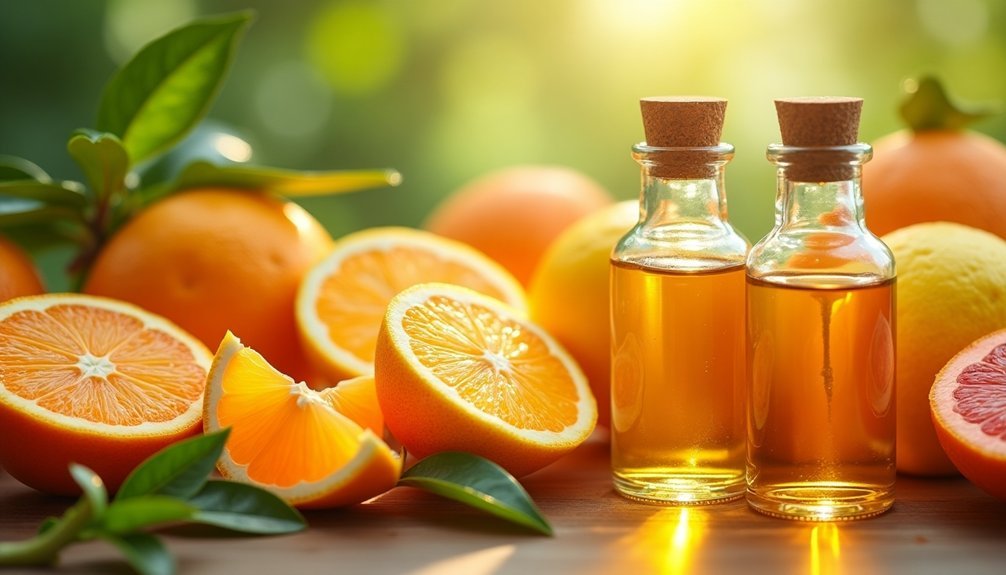To create vibrant homemade citrus cologne, start with classic combinations like bergamot and orange for a clean, professional scent, or lime and bergamot for a zesty profile. Mix your chosen oils into perfumer's alcohol at 3-5% concentration, and always follow proper dilution guidelines for safety. Don't forget to balance your citrus top notes with complementary middle and base notes for lasting power. The perfect signature scent awaits as you explore these aromatic possibilities.
Understanding Citrus Oil Properties in Cologne Making

While creating a signature cologne with citrus oils requires careful consideration, understanding their fundamental properties is essential for success.
You'll want to start with cold-pressed oils, as this extraction method preserves the vibrant fragrances and beneficial compounds found in citrus rinds. A state-of-the-art expression machine process ensures the highest quality oil extraction. These oils typically serve as top notes, providing that initial burst of freshness in your cologne.
You'll need to be mindful of safety considerations when working with citrus oils. They're phototoxic in their concentrated form, so proper dilution is vital to prevent skin reactions.
While they offer therapeutic benefits like mood enhancement and antimicrobial properties, you'll need to balance them carefully with other fragrance components.
Remember that citrus top notes fade quickly, so they work best when layered with longer-lasting middle and base notes.
Essential Equipment and Ingredients for Citrus Cologne
You'll need precise measuring equipment like glass beakers and pipettes to create consistent citrus cologne blends.
Your mixing tools should include glass stirring rods, metal spatulas, and a magnetic stirrer to guarantee thorough ingredient combination. Keep safety glasses nearby when working with volatile citrus oils.
For proper storage and blending, gather high-quality glass mixing jars, funnels, and perfume bottles with secure caps and eye-droppers.
Mixing Tools and Storage
Three essential categories of equipment form the foundation of successful citrus cologne creation: mixing tools, storage containers, and safety gear.
You'll need glass beakers and stirring rods for mixing your citrus oils, along with pipettes for precise measurements and metal spatulas for handling solid ingredients. A magnetic stirrer can make blending more efficient. Drawing from ancient perfumery traditions, having mortar and pestle tools available helps incorporate natural ingredients properly.
For storage, invest in dark glass bottles with eye-droppers and airtight caps to protect your creations from light degradation. Don't forget to label each container clearly.
Keep safety equipment within reach: protective gloves, safety glasses, and a lab coat or apron are must-haves. Work in a well-ventilated space and use a mask when handling strong fragrances.
Remember to keep fragrance blotters, filter paper, and your notebook handy for testing and documenting your blends.
Quality Measuring Equipment
Since precise measurements can make or break your citrus cologne, investing in quality measuring equipment is crucial.
You'll need a digital scale that measures down to 0.01g, as standard kitchen scales won't provide the accuracy required for essential oils. Opt for jewelry or gemstone scales for the best results.
For liquid measurements, you'll want to use disposable pipettes or graduated syringes. Keep these tools meticulously clean to prevent contamination.
When testing your blends, use smelling strips to evaluate the fragrance without skin contact. These strips help you identify the different notes and adjust your blend accordingly.
Remember to choose ceramic or glass equipment over plastic, as essential oils can react with plastic materials.
Always maintain clean equipment and follow IFRA guidelines to guarantee your cologne's safety and quality.
Essential Mixing Containers
When crafting citrus cologne, selecting the right mixing containers proves essential for maintaining the integrity of your fragrance.
You'll want to choose materials that won't react with your oils or compromise your blend's purity.
Here's what you'll need for proper mixing:
- Glass or Pyrex measuring beakers – they're ideal for their non-reactive properties and accurate measurements
- Ceramic containers with intact glazing – they work well for larger batches
- Stainless steel tools – perfect for stirring and mixing your citrus oils
- Clean pipettes – essential for precise measurements and avoiding cross-contamination
Don't use plastic containers, as they can absorb oils and alcohol, potentially ruining your cologne.
Lab equipment suppliers offer the best selection of professional-grade containers, ensuring you'll have the right tools for your citrus cologne creation.
Top 5 Citrus Oil Combinations for Men's Fragrances
The art of crafting men's fragrances reaches new heights with citrus oil combinations that deliver both sophistication and freshness.
For a classic masculine scent, try blending bergamot and orange oils, which create a clean, invigorating foundation perfect for daily wear.
You'll love the lime and bergamot combination, offering a zesty profile that's ideal for professional settings.
For evening occasions, explore the citrus spice blend of orange, cinnamon, and clove oils, creating a warm, inviting aroma.
If you're seeking something unique, combine grapefruit and orange with mint notes for an energizing twist.
The fifth must-try combination pairs bergamot and lemon with woody notes like cedarwood, delivering a sophisticated cologne that balances fresh citrus with deep, earthy undertones.
Each blend can be customized with carrier oils for safe skin application.
Balancing Notes: Creating Depth With Citrus Blends

To build a sophisticated cologne with citrus oils, you'll need to balance their bright, fleeting nature with deeper base notes.
When you pair citrus top notes like bergamot or grapefruit with grounding base notes such as sandalwood or patchouli, you'll create a fragrance with staying power and complexity.
Your blend should follow the 30/50/20 rule, using 30% citrus top notes balanced against 50% middle notes and 20% base notes for ideal depth and longevity.
Layering Top With Base
Creating depth in citrus cologne requires strategic layering of top and base notes to achieve a balanced, long-lasting fragrance.
You'll want to start with vibrant citrus oils as your top notes, then carefully blend them with stable base notes like vanilla, sandalwood, or benzoin for longevity.
- Use fixatives like Ambrocenide to enhance and lock in the citrus character
- Experiment with different ratios until you find the perfect balance between freshness and depth
- Consider adding complementary middle notes like florals or fruits for complexity
- Select high-quality ingredients to guarantee maximum fragrance performance
When blending, remember that citrus oils are naturally volatile, so you'll need strong base notes to anchor them.
Your goal is to create a harmonious composition where the bright, energetic citrus notes shine through while being supported by a solid foundation that extends wear time.
Grounding Bright Citrus Notes
While citrus oils naturally gravitate toward the top of fragrance compositions, you'll need strategic complementary notes to ground their bright, effervescent character.
To create lasting depth in your cologne, pair citrus oils with woody base notes like cedarwood, vetiver, or sandalwood. These combinations will anchor your blend while maintaining the uplifting qualities of citrus.
You can further enhance stability by incorporating heart notes such as jasmine, violet, or palo santo. These middle layers bridge the gap between your citrus top notes and deeper base elements.
For added complexity and longevity, consider adding patchouli or incense. If you're working with bergamot or grapefruit, their natural bitterness provides an excellent foundation for more sophisticated blends that won't fade quickly when properly anchored with these complementary ingredients.
Safety Guidelines for Working With Phototoxic Oils
Since phototoxic citrus oils can cause severe skin reactions when exposed to UV light, understanding proper safety measures is essential for creating safe cologne formulations.
When working with cold-pressed citrus oils like bergamot, lemon, lime, and grapefruit, you'll need to follow strict dilution guidelines and UV exposure precautions.
- Keep cold-pressed bergamot at 2 drops per 30ml carrier oil, while lemon can go up to 12 drops
- Consider using steam-distilled or FCF versions of citrus oils to eliminate phototoxicity risk
- Never exceed maximum usage levels when combining multiple phototoxic oils
- Warn users to avoid UV exposure for 12-18 hours after cologne application
For the safest formulations, opt for non-phototoxic alternatives like sweet orange, green mandarin, or tangerine to create bright, citrusy top notes without safety concerns.
Storage and Shelf Life of Citrus-Based Colognes

Proper storage directly impacts the quality and longevity of your citrus-based cologne formulations. Since citrus oils are particularly prone to degradation, you'll need to protect them from environmental factors that can compromise their integrity.
Store your colognes in dark, amber, or cobalt glass bottles with tight-sealing atomizers, and keep them in a cool, dark place away from heat sources and direct sunlight. You can use a dedicated perfume box, display case with glass doors, or even your refrigerator for ideal preservation.
When possible, maintain the original packaging to preserve the airtight seal. After each use, seal your bottles immediately and minimize the time they spend outside their storage space.
These practices will help maintain your cologne's composition and effectiveness, especially important since citrus-based fragrances require extra care for maximum shelf life.
Step-by-Step Mixing Process for Perfect Citrus Scents
Creating the perfect citrus-based cologne requires a methodical approach to mixing and blending essential oils.
You'll need to start by gathering your supplies, including perfumer's alcohol, essential oils, and sterile mixing equipment.
For the best results, follow these key steps:
- Select your citrus oils (like bergamot, lemon, or wild orange) as your top notes
- Add complementary middle and base notes to create depth
- Mix oils slowly into your alcohol base at a 3-5% concentration
- Allow your blend to rest for at least 24 hours
Once you've combined your ingredients, you'll need to filter the mixture through a coffee filter to remove any sediment.
Pour your finished cologne into a glass bottle and test it on your skin to guarantee the scent profile meets your expectations.
Frequently Asked Questions
Can I Use Citrus Oils Directly on My Skin Without Diluting Them?
No, you can't apply citrus oils directly to your skin. You'll risk chemical burns, blistering, and severe reactions. Always dilute them with carrier oils according to recommended ratios to protect your skin.
Will Citrus Cologne Stain My Clothes or Jewelry?
Yes, your citrus cologne can stain clothes, especially light-colored or synthetic fabrics. Apply it before dressing and let it dry. For jewelry, avoid direct contact as it may damage finishes or sensitive materials.
How Can I Make My Citrus Cologne Scent Last Longer?
You'll get longer-lasting citrus scents by using fixatives like frankincense, applying to moisturized skin at pulse points, increasing oil concentration to 30-40%, and layering with complementary base notes like vanilla or patchouli.
Should I Avoid Certain Medications When Wearing Citrus-Based Cologne?
If you're taking statins, SSRIs, or Everolimus, consult your doctor about wearing citrus-based cologne. While topical use is generally safe, it's better to be cautious if you're on medications metabolized by CYP3A4 enzymes.
Can I Use Dried Citrus Peels Instead of Essential Oils?
While you can use dried citrus peel extracts, they won't be as potent or long-lasting as essential oils. They're better suited for cleaning products, and you'll need to use more to achieve similar scent strength.
In Summary
Now that you've learned the art of blending citrus oils for cologne, you're ready to create your own signature scent. Remember to store your creations in dark glass bottles, follow safety guidelines for phototoxic oils, and start with small test batches. Don't be afraid to experiment with different combinations, but always document your successful formulas. With practice, you'll master the perfect balance of fresh, energizing citrus notes.
References
- https://naturallivingfamily.com/homemade/body-care/diy-essential-oil-cologne/
- https://www.food.com/recipe/lemon-cologne-67631
- https://www.mindbodygreen.com/articles/diy-perfume-how-to-make-your-own-at-home-3-blends-to-try
- https://www.aromaweb.com/essentialoils/citrus-essential-oils.php
- https://www.savvyhomemade.com/how-to-make-cologne/
- https://adv-bio.com/the-boom-of-citrus-oil/
- https://anthonymarmin.com/the-perfume-blog/citrus-in-perfumery
- https://www.ouroilyhouse.com/diy-mens-cologne/
- https://www.perfumeryschool.com/tools-and-equipment
- https://shop.perfumersapprentice.com/c-60-bottles-tools-and-equipment.aspx





Leave a Reply